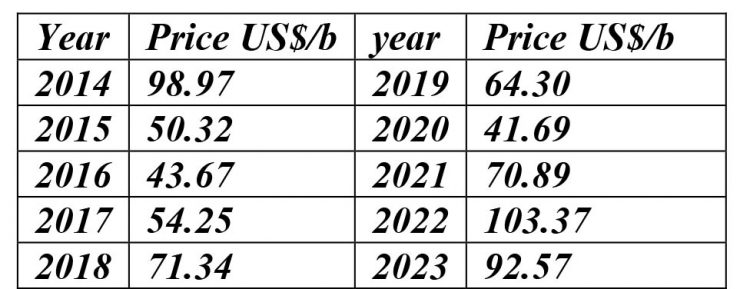Introduction
Today’s column presents brief commentary on three topics; namely, 1] the estimated break-even prices for Guyana’s crude 2] likely Brent crude oil price going forward, and 3] the World Bank’s prediction of a Guyana “boom cycle” going forward. The presentation on break-even prices simply wraps-up last week’s treatment of modelled cost shares for ExxonMobil’s five already announced projects to 2025/6.
Break-even price
As indicated this is a summary wrap-up comment on last week’s presentation of a modeled cost shares for Exxon Mobil crude oil cost of production in the Stabroek Bloc covering its first five projects to target year 2025/6. Stock analysts, writing in Seeking Alpha recently have, estimated these break-even prices as follows, in US$ per barrel.; Projects 1-4, cost 35 25 32 29 respectively. Over the long-term the range is projected at 27 t0 29 USD/b and production at 2.1 to2.5 million barrels per day.
Brent Crude Price
Below I reproduce substantially the recent Energy Information Administration, EIA forecast of Brent crude prices to 2023.
EIA Global liquid fuels forecast
● The EIA’s April Short-Term Energy Outlook (STEO) reports on elevated uncertainty due to a number of factors, especially related to the Russia – Ukraine war. The STEO assumes U.S. GDP growth of 3.4% in 2022, and 3.1% in 2023, following 5.7% in 2021. Global GDP growth of 4.0% in 2022 and 3.7% in 2023 are also predicted, compared to 6.0% in 2021.
● Variations in macroeconomic outcomes are expected to affect energy markets significantly.
● Supply uncertainty arises from the conflict in Ukraine; OPEC+ production decisions; and the rate at which U.S. oil and natural gas producers increase drilling.
● The Brent crude oil spot price averaged US$117 per barrel in March, a US$20 increase from February. Crude oil prices increased following the Russia-Ukraine war. Russian sanctions and other actions contributed to falling oil production and created significant market uncertainties over further oil supply disruptions.
● These events occurred against a backdrop of low oil inventories and persistent upward oil price pressures. Global oil inventory draws averaged 1.7 million barrels per day (b/d) from the third quarter of 2020 through the end of 2021. EIA estimates that commercial oil inventories in the OECD ended Q1 2022 at 2.61 billion barrels, up slightly from February, which was the lowest level since April 2014.
● The EIA expects the Brent price will average US$108/b in Q2 2022 and US$102/b in the second half of 2022. The average price is expected to fall to US$93/b in 2023. However, this price forecast is highly uncertain.
● Actual price outcomes will depend on the degree to which existing sanctions imposed on Russia, any potential future sanctions, and independent corporate actions affect Russia’s oil production or the sale of Russia’s oil in the global market.
● Also, other oil producers response along with macroeconomic developments will impact global oil demand, and price formation going forwards.
● Although Russia’s oil production is reduced in the forecast, EIA still expects that global oil inventories will build at an average rate of 0.5 million b/d from Q2 2022 through the end of 2023. EIA expects this will put downward pressure on crude oil prices. However, if production disruptions—in Russia or elsewhere—are more than it forecasts, the resulting crude oil prices would be higher than their current forecast.
● Further the EIA estimates that 98.3 million b/d of petroleum and liquid fuels was consumed globally in March 2022, an increase of 2.4 million b/d from March 2021. It forecasts that global consumption of petroleum and liquid fuels will average 99.8 million b/d for all of 2022, which is a 2.4 million b/d increase from 2021. However, this forecast is down by 0.8 million b/d from last month’s forecast as a result of downward revisions to global GDP growth from Oxford Economics. They forecast that global consumption of petroleum and liquid fuels will rise by 1.9 million b/d in 2023 to average 101.7 million b/d. The outlook for economic growth and oil consumption in Russia and surrounding countries continues to Source EIA, STEO April 2022
The Table below shows Brent crude oil prices historical and estimated over ten years, 2014 – 2023.
“Boom cycle”
Writing recently on Guyana’s economy the World Bank has offered the opinion that Guyana’s oil resources are locked- in a “boom cycle” for the next two years and beyond, going forward. The GDP growth rates for last year and projected for this year are 21.3 percent and 49.7 percent, respectively. Indeed, between the year of Guyana’s first oil. 2019, and 2030 the World Bank projects its GDP will more than treble in value! Of course, by then the share of the oil and gas sector in GDP will exceed 25 percent. Further the per capita GDP will be around US$17,000 – close to high income. Other development partners share this view. Thus, the Economic Commission for Latin America, ECLAC has offered a 2021 growth rate of 18.5 percent and projects this year at 46.0 percent
Conclusion
Next week I continue with other indicators of the condition of Guyana’s nascent petroleum- driven economy








